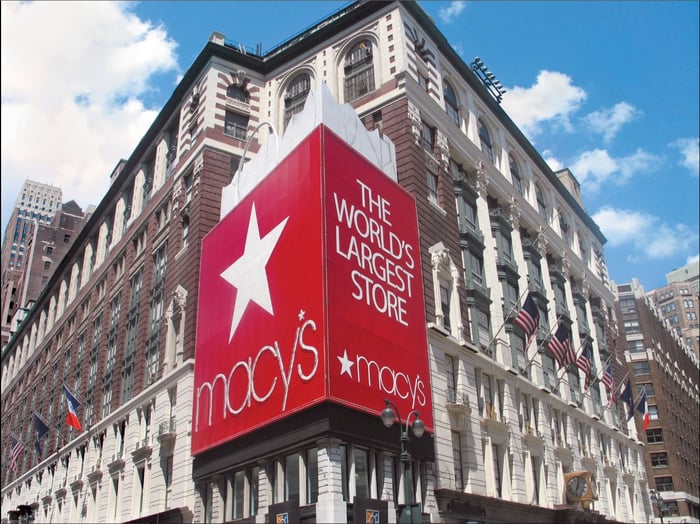A little more than a year ago, department-store giant Macy's (M 0.86%) closed the sale of its 248,000-square-foot men's store in downtown San Francisco. This deal -- one of its biggest moves so far in its quest to monetize some of its valuable real estate -- brought in proceeds of $250 million.
During 2017, Macy's also announced plans to lease out 10,000 square feet of ground floor space in its San Francisco flagship store, which stands around the corner from the men's store. This valuable space facing Union Square could bring in $6 million to $7 million of rent annually.
Macy's isn't done trying to extract value from its San Francisco real estate, though. It's now looking to sell part of the San Francisco flagship, in a development that the San Francisco Chronicle reported on last Monday and that the company confirmed Tuesday morning. If this sale process is successful, it will bring in another big windfall for Macy's.

Macy's hopes to sell part of its San Francisco flagship store this year. Image source: Macy's.
Macy's is thinking hard about its best real estate
Last quarter, Macy's broke a long streak of sales declines, posting comp sales growth of 1.4%. This performance drove a strong double-digit increase in earnings per share, even excluding the benefit of tax reform and the gain from the sale of the San Francisco men's store.
Despite these strong results, Macy's remains committed to its strategy of monetizing real estate where the potential sale price exceeds the value of its retail operation. Indeed, the recent reduction in the corporate tax rate increases the attractiveness of an immediate cash windfall relative to a long-term stream of retail profit.
Thus, while the Macy's Union Square flagship store is extremely successful, the high value of prime San Francisco real estate means it still makes sense to consider giving up some more space. The store actually consists of several structures that were joined together over time. One of these is the 240,000-square-foot I. Magnin building, formerly home to a rival department store by that name. Macy's now hopes to sell this portion of the flagship store.
Today, Macy's has nearly 1.2 million square feet of space in downtown San Francisco: 937,000 square feet in the Union Square flagship, plus 248,000 square feet in the men's store, which hasn't closed yet. Even after closing the men's store and selling the I. Magnin building, Macy's would have nearly 700,000 square feet of space. That would still make it the third largest store in the chain, behind the New York and Chicago flagship stores, and the largest department store in San Francisco.

The Manhattan flagship is the largest Macy's store. Image source: Macy's.
The time is now
This is an opportune time for Macy's to sell the I. Magnin building. First, the buoyant regional economy has driven San Francisco real estate values sky-high. That may not last forever. After all, there was a big bust in the early 2000s, after the dot-com crash.
The I. Magnin building is slightly smaller than the men's store building, which sold for $250 million. However, it has an even better location, right on the corner of Union Square. This advantage could put its value at about $250 million to $300 million. That roughly lines up with management's estimate that asset sale proceeds for the full year will be $340 million to $370 million, primarily coming from this one building.
A second reason for doing a deal this year is that Macy's is already making investments to reconfigure the main store to accommodate the men's collection. It would be far more efficient to renovate the store all at once, rather than consolidating the men's merchandise into the main store now and then downsizing it a few years down the road.
This is the right move
Some pundits think Macy's has become too reliant on real estate sales in recent years. They worry that by closing some stores and downsizing others, Macy's risks losing its relevance with consumers.
However, there's simply no need for the cavernous department stores of yesteryear anymore. The biggest advantage of these stores was their broad selection of merchandise. That's not much of a competitive advantage today, when Macy's and all of its competitors can offer an even wider selection of items on their e-commerce sites.
Downtown flagship stores in heavily trafficked shopping districts still attract plenty of customer traffic. Nevertheless, they can continue to be extremely successful with less square footage. In the meantime, Macy's can use its asset sale proceeds to pay down debt, putting it in better position to react to future challenges.





